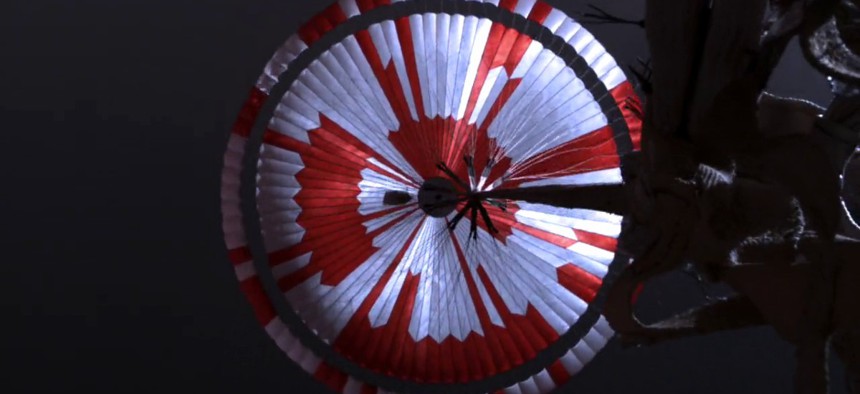Mars Perseverance Mission Already Producing Amazing Moments

NASA's Mars Perseverance rover acquired this image during its descent to Mars, using its Parachute Up-Look Camera A. This camera is mounted on the spacecraft's backshell and looks up at the parachute. NASA/JPL-Caltech
Watching the rover plummet only to perform a delicate, ballet-like finish was breathtaking.
Those of you who read my Nextgov emerging tech columns know of my great love for space exploration, artificial intelligence, robotics and new technologies. That’s why I cover NASA so often, and especially the wizards at the Jet Propulsion Laboratory. They generally have access to some of the most remarkable emerging technology within government.
So of course I was excited to hear that the Perseverance rover landed safely on Mars without any problems. But I figured it would be a little while before we started to get any news from the red planet. NASA had other ideas and is already pushing into some of the most interesting aspects of the new Mars mission.
The one item that is on hold—for now—is the first flight of the amazing Ingenuity Mars Helicopter. As planned, it’s currently tucked underneath the belly of Perseverance where it can draw power and heat from the onboard Multi-Mission Radioisotope Thermoelectric Generator (MMRTG). The generator produces both heat and electricity from the natural radioactive decay of its plutonium core.
In a few weeks, the Ingenuity Helicopter will be dropped off on the surface of Mars and be totally on its own. It will have to generate power from its solar panels and survive the nighttime temperatures that can plummet down to minus 100 degrees Fahrenheit. For now, it’s tucked away and safe, so we will have to wait to see how it performs once it gets ready to take flight.
But don’t think that means that nothing is happening on Mars. Things have been pretty exciting, right from the landing. For the first time, the so-called seven minutes of terror that Mars crafts go through when touching down, where they have to rely on their automated systems to avoid a crushing plunge onto the rocky planet, was recorded using HD cameras. Watching Perseverance fall at hundreds of meters per second only to perform a delicate, ballet-like finish using the now-famous sky crane, was breathtaking.
Watching the landing in HD was like seeing a Hollywood movie. Of course, because of the time lag in transmitting data from Mars, we already knew that there was a happy ending. But I could not help to feel a little nervous watching the red soil rushing ever closer.
Even though the mission is slated to last a year and a half, and the MMRTG can technically supply power for up to 15 years, NASA wasted no time getting to work. They need to, because the closest Mars ever is to earth puts it 34.63 million miles away, so there is no possibility of a tune-up if something goes badly. Right now, Perseverance is 130.2 million miles from home with a long list of tasks in front of it, the biggest one being a search for signs of ancient or current life on Mars. I can’t even imagine how a discovery like that would change the world.
For now, we will have to settle for gazing at some surreal HD photos of Mars, the first of which are starting to stream in as Perseverance gets to work. However, one of the other major milestones that a lot of people were excited about, the ability to hear what Mars sounds like, is already happening.
NASA attached a commercial off-the-shelf microphone to the rover. It survived the landing and started listening to the planet around it. A few minutes after touchdown, it recorded the sounds of a Martian breeze passing over the rover as it sat in the base of the Jezero Crater.
A lot of the Martian sounds were drowned out by the noise of the rover itself, but the agency later filtered out the mechanical noise to give listeners a pure audio stream of Martian wind. The breezes there sound similar to ones on Earth, but might be a little bit off because of the thin atmosphere and the way that sound travels there. I am looking forward to hearing longer audio streams as the mission continues.
There are a lot of amazing first steps ahead of Perseverance over the next year, not the least of which is the first flight of the Ingenuity helicopter. But even within the first few minutes of its arrival on Mars, Perseverance already started making history. And the world almost can’t wait to see what’s next.
John Breeden II is an award-winning journalist and reviewer with over 20 years of experience covering technology. He is the CEO of the Tech Writers Bureau, a group that creates technological thought leadership content for organizations of all sizes. Twitter: @LabGuys



